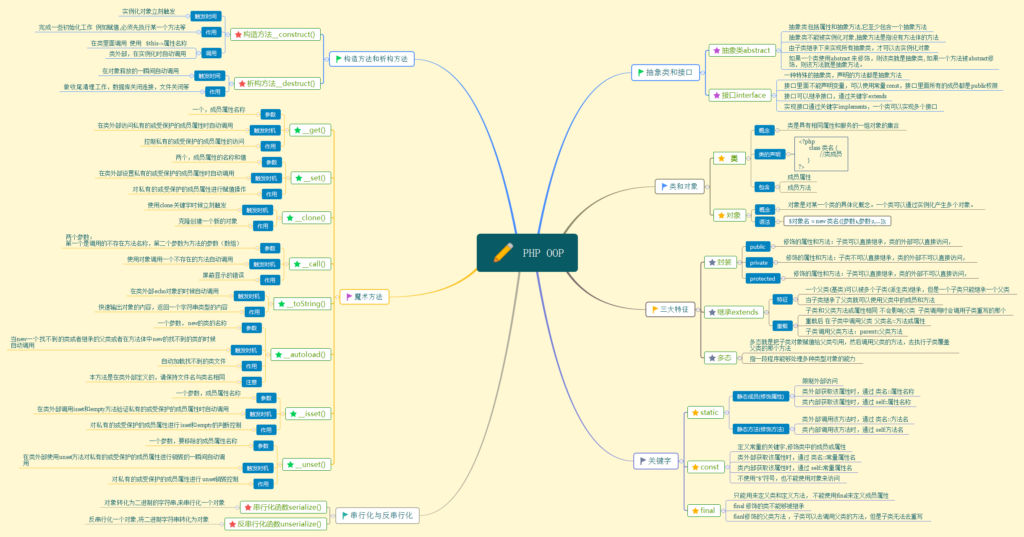
OOP Advanced Concepts

Understanding Inheritance, Traits, Abstract Classes, Interfaces, and Overloading in PHP
PHP has evolved from a procedural scripting language to a powerful object-oriented programming (OOP) language. While it still supports procedural coding, modern PHP encourages object-oriented design. However, it does have its quirks when compared to other OOP languages. In this article, we’ll explore PHP’s inheritance model, how it compensates for its limitations using trait, and how abstract classes, interfaces, and overloading are implemented.
1. Class Inheritance in PHP
1.1 Single Inheritance
PHP supports single inheritance, meaning a class can inherit from only one parent class. Typically, we define shared methods and properties in a base class and allow child classes to extend it using the extends keyword.
Example Use Case:
In an API controller base class, we might define common properties such as $data, $statusCode, and methods for success and error responses.
Key Concepts:
- Private Properties: Inherited, but not accessible from the child class directly.
- Protected Properties/Methods: Inherited and accessible in child classes. Ideal for inheritance.
parent::Keyword: Used to call the overridden method from the parent class.self::Keyword: Static binding; resolved at compile time.static::Keyword: Late static binding; resolved at runtime based on the calling class.finalKeyword: Prevents class inheritance or method overriding.
1.2 Chain Inheritance (Multiple Levels)
Since PHP does not support multiple inheritance, developers sometimes resort to deep inheritance chains like:LivingThing → Animal → Human → Man → Walk().
While this works, it can lead to tight coupling, complex maintenance, and performance issues. Avoid deep inheritance trees when possible.
2. Using Traits for Horizontal Reuse (Pseudo-Multiple Inheritance)
PHP introduced traits to overcome the limitation of single inheritance. Traits allow classes to reuse methods across unrelated classes. Traits is the partial class including properity and methods.
Example:
Shared behaviors like walk, eat, and sleep can be placed in a trait and reused in classes like Elephant, Man, or Woman.
Syntax:
trait WalkTrait {
public function walk() {
echo "Walking...";
}
}
class Human {
use WalkTrait;
}Key Characteristics of Traits:
- Cannot be instantiated.
- Cannot define class constants.
- Can define both abstract and concrete methods.
- A class can use multiple traits:
use TraitA, TraitB; - If traits have methods with the same name:
- Use
insteadofto resolve conflicts. - Use
asto alias methods and optionally change visibility.
- Use
Trait Conflict Resolution Example:
trait A {
public function sayHello() {
echo "Hello from A";
}
}
trait B {
public function sayHello() {
echo "Hello from B";
}
}
class Greeting {
use A, B {
B::sayHello insteadof A;
A::sayHello as sayHelloFromA;
}
}Trait Summary:
- Traits sit between abstract classes and normal classes.
- They’re ideal for shared functionality across unrelated classes.
- Trait methods can be overridden by the class itself.
- Traits allow for DRY (Don’t Repeat Yourself) coding practices.
3. Abstract Classes vs Interfaces
3.1 Abstract Classes
An abstract class provides a base for other classes to extend. It can define both abstract methods (no implementation) and concrete methods (with implementation). An abstract class cannot be instantiated directly.
Example:
abstract class Vehicle {
abstract public function startEngine();
public function honk() {
echo "Beep!";
}
}
class Car extends Vehicle {
public function startEngine() {
echo "Car engine started.";
}
}3.2 Interfaces
Interfaces define a contract for classes. All methods must be public and abstract. Interfaces cannot contain properties or concrete methods.
Key Points:
- A class uses the
implementskeyword to implement an interface. - A class must implement all methods from the interface.
- Interfaces cannot contain implementation logic, only method signatures.
- Interfaces can be extended by other interfaces (multiple inheritance supported).
Example:
interface Engine {
public function start();
}
class Boat implements Engine {
public function start() {
echo "Boat engine started.";
}
}Abstract Classes vs Interfaces – Quick Comparison
| Feature | Abstract Class | Interface |
|---|---|---|
| Instantiation | Not allowed | Not allowed |
| Methods | Both abstract and concrete | Only abstract (public only) |
| Properties | Allowed | Not allowed |
| Constants | Allowed | Allowed (public only) |
| Inheritance | Single inheritance | Multiple inheritance (extends) |
| Use Case | Shared behavior + structure | Behavioral contract (APIs) |
4. Overloading in PHP (Magic Methods)
PHP doesn’t support method overloading in the traditional (compile-time) sense. Instead, it uses magic methods to handle undefined properties and methods dynamically.
4.1 Property Overloading
| Magic Method | Triggered When… |
|---|---|
__get($name) | Accessing an undefined or inaccessible property |
__set($name, $value) | Setting an undefined or inaccessible property |
__isset($name) | Calling isset() on undefined/inaccessible property |
__unset($name) | Calling unset() on undefined/inaccessible property |
__toString() | Echoing an object as a string |
4.2 Method Overloading
| Magic Method | Triggered When… |
|---|---|
__call($name, $args) | Calling undefined/inaccessible instance method |
__callStatic($name, $args) | Calling undefined/inaccessible static method |
Example:
class DynamicHandler {
public function __call($name, $arguments) {
echo "Method $name not found!";
}
}
$obj = new DynamicHandler();
$obj->foo(); // Outputs: Method foo not found!Conclusion
Understanding PHP’s object-oriented capabilities allows you to build more robust, scalable, and maintainable applications. While PHP has limitations like the lack of traditional multiple inheritance or overloading, it compensates well through features like traits and magic methods. Abstract classes and interfaces help enforce structure and consistency, especially in team or large-scale development. By mastering these tools, you’ll be well-equipped to write clean, reusable PHP code.



Comments are closed.